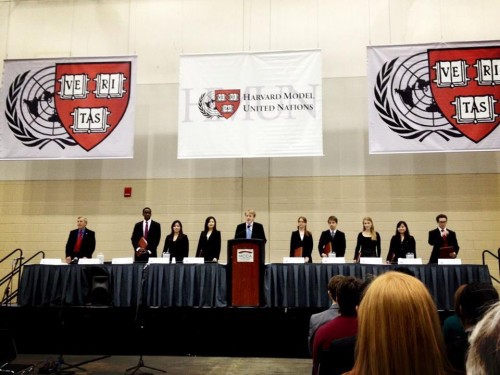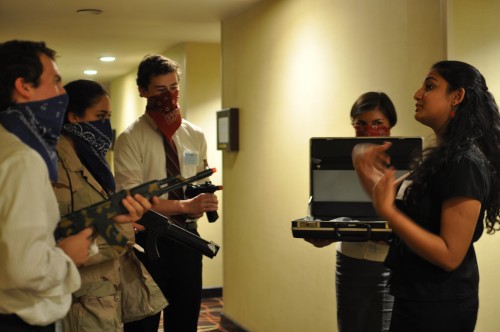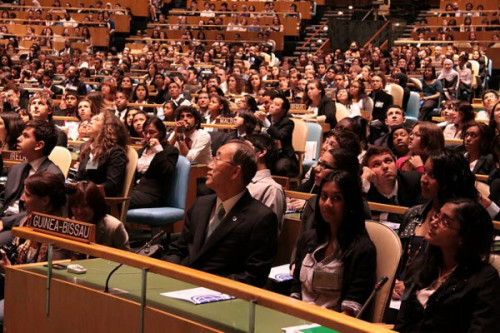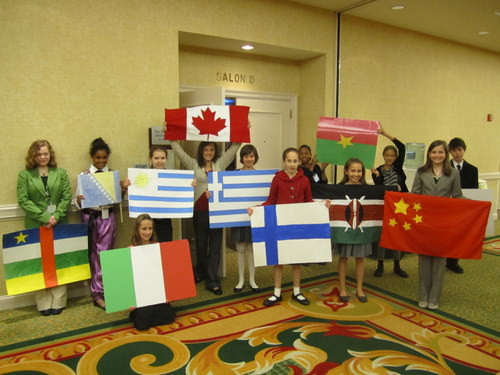Model UN conferences seem to like to debate who came first or who was the first to have a particular innovation or feature. That is not meaningful when impact is valued over history, though Event #1 does make mention of this debate. Therefore, this article is not a list of who was the first conference in whatever geographical region or country or specialization someone claims they are — it’d be listing hundreds of conferences if that were the case.
Rather, this is a list of ten of the most significant events in Model UN history as defined by its subsequent global impact on the expansion or development of Model United Nations. In other words, the founding of the conferences or organizations mentioned below is important because it led to the growth of tens of thousands of perpetual delegates, brought Model UN to a multinational demographic where the activity was previously unavailable or inaccessible, or significantly changed the way Model UN has evolved as an activity.
Since Model UN expansion and innovation has been exponential — and perhaps correlated with globalization or the technology revolution (see Bonus Event #11) — over half the significant events selected took place within a golden decade for Model UN growth between 1999-2009. Finally, it’s important to keep in mind that not every event may be perceived to be important to every participant because everyone has different MUN experiences. Nevertheless this is an attempt to analyze the overall history of Model UN.
Here are ten of the top events in the history of Model United Nations in chronological order:
1. 1952, 1953, 1954: Founding of Berkeley MUN, Harvard MUN, and Harvard National MUN started modern-day Model UN
The first modern Model UN conferences are important because, well, they started Model UN! We could argue the semantics of who was the first Model UN conference, especially if a single simulation of the UN that was not related to the existing MUN conference could be counted as part of the conference’s history*. But for the purposes of this article’s emphasis on subsequent impact on the history of Model UN, the following three continuously operating conferences were selected to share Event #1 and their three claimed start dates are below.
- 1952: Berkeley Model United Nations (BMUN) — first high school MUN**
- 1953: Harvard Model United Nations (HMUN)
- 1954: Harvard National Model United Nations (HNMUN) — second university MUN***
BMUN is credited as the first modern Model UN conference at the high school level, the largest demographic of MUN participants. It continues to be the largest university-hosted high school conference in the western United States, where a large West Coast high school MUN circuit has evolved to become arguably the most developed MUN region in the world with 200-person clubs, high schools hosting conferences with 1,000+ delegates, and MUN classes integrated with AP and IB curriculum.
However, Harvard is the university that has most significantly shaped Model UN globally. HMUN and HNMUN continue to be two of the largest conferences in the world at their respective academic levels and attended by many international schools and universities (WorldMUN is mentioned separately as Event #4). Recently, these conferences have expanded abroad (e.g. HMUN China, HMUN India, HNMUN Latin America), further spreading Harvard’s influence. This is why MUN delegates outside the USA sometimes say they know or use “Harvard procedure” when they are really referring to a generic North American style procedure with moderated and unmoderated caucuses that was derived from American Congressional procedure and codified by Robert’s Rules of Order.
The MUN community in the USA has grown significantly since then and many prestigious conferences have since been established that contribute to the United States’ influence on the Model UN activity worldwide. Conferences with a history of hosting 3,000+ delegates and large international attendance have a similar influence as HNMUN and HNMUN, and these include but are not limited to NAIMUN founded in 1963, NMUN in 1968, NHSMUN in 1975****. The United States itself benefits from this long history and continues to be the most developed Model UN country in the world by most measures: total conference attendance, number of large conferences (1500+ delegates), mass availability of conferences at all academic levels, innovation of MUN committees (e.g. diversity of crisis committees), and academic rigor in MUN due in part to the existence of MUN classes at the high school and university levels and in part to the top-tier universities that draw top students from around the world as conference staff and participants.
—
*Note: For those who are interested in Model League of Nations and Model UN simulations that predate modern MUN conferences, Bill Yotive from the United Nations Department of Public Information has been conducting research on primary and secondary sources from the 1920s-1950s on the history of Model UN. I have left out the specific dates and information since I have not seen the sources, and we’ll have to wait for Bill’s research to be published to learn more. But for the purposes of this article:
- 1925: the oldest simulation of the League of Nations was at Harvard University. This has no relation to the current Harvard MUN conference which started in 1953. (This date is from my research; Bill Yotive may have a different date and source).
- 194_: Franklin D. Roosevelt coined the term “United Nations” in 1942 in the Declaration by United Nations. It’s possible that a simulation of the “United Nations” existed before the actual United Nations organization was created in 1945.
- 195_: the oldest Model UN simulation of the UN organization itself was held at an East Coast university in the United States and pre-dates any of the concrete dates listed in this section. This has no relation to that university’s current MUN conference which started in the 1990s.
**Note: Gannon University Model United Nations is in its 63rd session in 2015 but was founded in 1954 instead of 1952; it’s likely that there were multiple sessions during one of the years. Therefore, it is not as old as BMUN or HMUN.
***Notes: Model United Nations of the Far West (MUNFW) is the oldest university MUN conference as it was started in 1951.
Also, National Model UN (NMUN) claims lineage tracing back to a 1923 League of Nations simulation and a 1946 Model UN simulation. However, the organization that hosts NMUN as a conference was formally incorporated in 1968 and the conference has been continuous at least since then — the website states “for more than 47 years” in 2015 — but the exact history or continuity before 1968 seems unclear. Therefore, we used the 1968 date. The 1923 and 1946 dates could be substantiated with primary or secondary sources from that period.
****Note: The National High School Model United Nations (NHSMUN) cites 1975 on their website. NHSMUN was spun off from NMUN in 1979, and NMUN’s history cites 1974 as the NHSMUN founding date. The discrepancy could mean it was incorporated in 1974 but its first conference was held in 1975 during the same 1974-1975 school year.
2. 1968: Founding of THIMUN led to the global expansion of high school Model UN
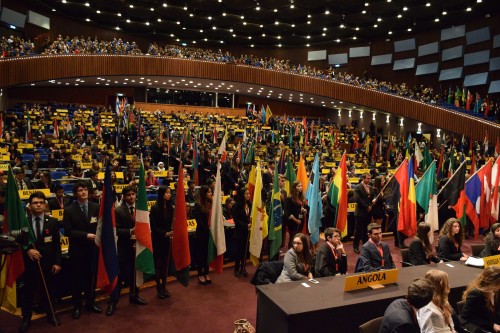
THIMUN procedure is used by international schools worldwide and is backed by a formal affiliation process
The founding of the The Hague International Model United Nations (THIMUN) conference in 1968 is important for three reasons*. First, the establishment of the first Model UN conference in Europe eventually led to the introduction of the Model UN activity to tens of thousands of high school students in not just throughout Europe but also throughout the Middle East, Africa, and Asia. Today, THIMUN Hague continues to be one of the largest and most internationally diverse conferences in the world.
Second, it established THIMUN procedure — which includes lobbying sessions and open and closed debate — derived from British parliamentary procedure that was more familiar to the schoolteachers at the international schools in The Hague and different from the existing North American procedure. THIMUN procedure continues to be the second most-used procedure in the world after general North American procedure, though it is relatively more standardized. Along with the procedure came a noncompetitive culture of Model UN that many students and teachers outside of the USA favored over the awards-centric American-style Model UNs.
And third, by combining its international reach and standardized procedure, it created a worldwide network of 6 THIMUN-branded conferences and 46 THIMUN-affiliated conferences across five continents (as well as many other conferences that use THIMUN procedure but are not formally affiliated), which are attended by a loyal following of international schools. Today, THIMUN Hague serves as the hub for European high school MUN, THIMUN Qatar serves as the hub for Middle Eastern high school MUN, and THIMUN Singapore serves as the hub for Southeast Asia high school MUN. And the THIMUN Foundation serves as the hub for this global network of Model UN conferences (as well as THIMUN Online MUN mentioned in Event #9) that impacts tens of thousands of students every year.
—
*Note: A potential fourth reason in the future could be the implementation of MUN as a possible internal assessment of the IB Global Politics course, which just launched recently. The International Baccalaureate observed THIMUN as part of its development of that course. This course would not be the first to include MUN as part of a social studies class (see Event #1) or even a school district’s curriculum (see Event #5), but it could be a potential way to scale it internationally.
3. 1972: Founding of NCSC led to the major substantive deviation of crisis committees in Model UN
The founding of the National Collegiate Security Conference (NCSC) in 1972 by Georgetown University is significant because it marked a major substantive deviation from simulations of the United Nations and related bodies. These simulations of government cabinets and non-UN organizations would evolve into the modern-day crisis committees that focus on impromptu and creative decision-making. Although NCSC started the concept of a crisis-specific conference, the vast majority of these types of committees gained popularity at conferences in the past decade, possibly correlated with international actions after the September 11, 2001 terrorist attacks*. Recently, crisis simulations have moved beyond the realm of international affairs into fantasy committees like Harry Potter and Star Wars. However, all of these crisis simulations were still branded as Model United Nations.
The rise of crisis MUNs this past decade came under public media spotlight in a 2013 New York Times article titled “The Dog-Eat-Dog World of Model U.N.” that detailed how crisis committees were featured or even now exclusive to the vast majority of North American university conferences. Critics of crisis committees pointed to their de-emphasis on academic research and preference for chaos (e.g. war games, kidnappings, assassinations) or fantasy over multilateral discussion of real life global issues and attempts at implementing peaceful and diplomatic solutions — they called crisis a “caricature of Model UN.” The UN itself was publicly critical of how far Model UN has deviated from its namesake organization after reading the New York Times article. Nevertheless, crisis continues to be relevant to real-world international affairs and enjoys growing popularity among Model UN participants at all academic levels.
—
*Note: The Security Council Simulation at Yale (SCSY) is the only other crisis-specific conference founded in this era in 1977, though it’s unclear when SCSY went from simulating only the UN Security Council to non-UN crisis committees. All other crisis-specific conferences were founded after 1995 with the majority after 2001, though it’s possible that traditional MUN conferences had been simulating one or two crisis committees alongside regular UN bodies before then.
4. 1991: Founding of Harvard WorldMUN led to the global expansion of university Model UN
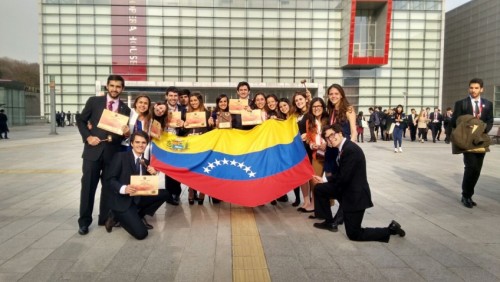
Top university Model UN teams now exist in different countries and they travel around the world to major conferences such as WorldMUN
The founding of Harvard WorldMUN in 1991 is significant because it accelerated the global spread of Model UN at the university level. Instead of only a few wealthy delegations coming to the USA for HNMUN or NMUN, Harvard went to different countries and exposed thousands of university students to MUN. WorldMUN is dubbed the “Olympics of Model UN” because the conference rotated to a different city around the world every year. In this process, WorldMUN has been hosted in over 20 countries on six continents and today is among the largest and most internationally diverse conferences in the world.
The conference oftentimes led to a sustainable legacy as the local host team that partnered with Harvard and local delegates could use their experience to build their local circuits after WorldMUN had left (at least from first-hand observation), thus further growing MUNs in different regions. Though it is difficult to measure causation versus correlation, almost every university MUN conference outside of North America was established in the past two decades after the founding of WorldMUN, and HNMUN and NMUN did not have significant international attendance until after the founding of WorldMUN*.
The global rotation of WorldMUN created four secondary impacts. First, it cemented the dominance of Harvard procedure — more broadly, North American procedure — at the university level worldwide. Second, the conference has led to a globalization of MUN travel schedules as returning teams willingly traveled to the conference every year regardless of where it was held. Third, the lack of financial or institutional support at some universities outside of North America led to the concept of the independent travel team starting with the founding of United Netherlands in 2004 and MUN Society Belgium in 2005. Independent travel teams now exist at different academic levels around the world. And fourth, the conference’s success proved that a model with a local host team partnering with an established organization could work, which paved the way for the global expansion of established conferences or importing of conference brands (depending on your perspective) in Event #7.
—
*Note: Another correlation test to determine WorldMUN’s impact on university MUN growth was to research HNMUN and NMUN’s international attendance history. HNMUN did not publish an international students’ handbook until 1998, and NMUN has only had two university groups outside of North America that have attended its conference for more than 20 years as of 2015 (since before 1995 if attendance was continuous). Therefore, these heavily international conferences only started to become so in the late 1990s after WorldMUN was founded.
5. 1999: Founding of UNA-USA Global Classrooms led to the global accessibility of Model UN
The United Nations Association of the United States of America (UNA-USA) launched its non-profit Global Classrooms program in 1999. Before then, Model UN conferences worldwide were mostly limited to wealthy elites from private schools and international schools or students from well-funded public schools. Backed by an initial $1 million grant from Merrill Lynch — plus an additional $7.5 million grant from Merrill Lynch and other philanthropic organizations in 2005 due to the success of the pilot program — Global Classrooms expanded rapidly for a decade and at its peak brought Model UN conferences for free to over ten thousand high school and middle school students annually at the UN Headquarters and in 24 other cities spread across five continents.
One word often used to describe the impact of the program was that it “democratized” MUN to economically disadvantaged students from inner-city public schools who previously could not afford to attend MUN conferences. Similarly, tens of thousands of students in state-run schools in other countries now had MUNs whereas previously THIMUN-affiliated conferences were mostly attended by the much smaller demographic of students from international schools. The program also made MUN more educational by developing free curriculum to be taught in social studies classrooms (hence the name “Global Classrooms”) so that these students could be more academically prepared. The curriculum was the first to be implemented in a large scale through partnerships with major school districts including the three largest ones in the USA*.
Global Classrooms created three secondary impacts. First, one word used to describe its impact was that it “standardized” MUN procedure as it was used in so many cities within and outside of the USA — many delegates referred to North American procedure in general as “UNA-USA procedure.” Second, the mission of the program influenced some established conferences to add outreach efforts, financial aid, or even a separate free or low-cost teaching conference in order to better serve this demographic. And finally, it helped create a stronger connection between Model UNs and the diplomatic community (Ban Ki-moon spoke multiple times at Global Classrooms conferences, and the U.S. State Department helps run Global Classrooms DC).
Unfortunately, Merrill Lynch was one of the major victims of the 2008 Financial Crisis and the grant eventually ran out, which led to the scaling down of the program. However, UNA-USA (now part of the UN Foundation) continues to sponsor its Global Classrooms International high school and middle school conferences at UN Headquarters (now operated by Global Classrooms Lebanon), and their curriculum continues on through the UNA-USA Model UN App. Several local Global Classrooms-branded conferences in the USA and abroad are still independently self-sustaining. Several MUN organizations have also been started by former staffers of Global Classrooms conferences (including Best Delegate).
—
*Note: The three largest school districts in the mainland USA were: New York City Department of Education, Los Angeles Unified School District, and Chicago Public Schools.
6. 2001: Winning London film led to the cultural popularity of Model UN
The movie Winning London, starring Mary-Kate and Ashley Olsen, was released in 2001 and to this date is still the only full-feature film where Model UN was the primary plotline. The popularity of the two teenage stars at the time and the appearance of Model UN in pop culture made a significant impact on a whole generation of students who attended high school in the 2000s to join Model UN — the movie was particularly cited by teenage girls during that period as one of the reasons why they joined Model UN.
No other pop culture reference has made as significant of an impact on Model UN as Winning London did, but pop culture references to Model UN continue to appear with increasing frequency to elevate the visibility of the activity. For example, Model UN was the primary plotline of an episode of the TV series Community in 2011 and of an episode of the TV series Parks & Recreation also in 2011.
7. 2005: Founding of Weland and rise of other Model UN companies led to the expansion of Model UN primarily in developing countries
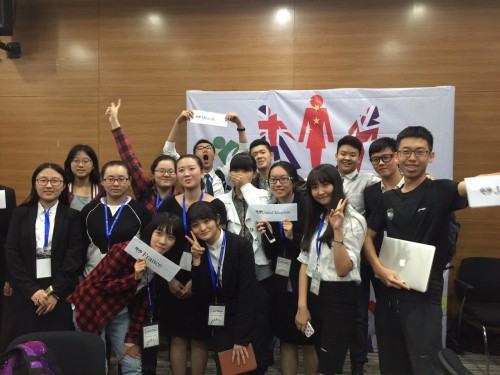
Thousands of students in countries such as China and India are now participating in Model UN through full-service MUN companies
Model UN companies have risen in the past decade to address an inefficiency that hindered MUN growth in the developing world. That inefficiency was that state-run schools did not have the academic incentive or institutional capabilities to support student-run MUN clubs, particularly in Asian countries that focused on test-taking over extracurricular activities. MUN companies capitalized on this inefficiency by offering full-service MUN experiences, and the result is explosive growth of tens of thousands of delegates who previously did not have MUN.
The rise of Model UN companies could be attributed to Weland, founded in China in 2005*, as they pioneered the highly visible strategy of importing MUN brands to its WEMUN Expo and as standalone domestic conferences (e.g. HMUN China, YMUN China, ILMUNC China**), a strategy that has since set off a multinational scramble by MUN companies to secure exclusive partnerships with established MUN conferences. Today, Model UN companies are most prominent and influential in China, India, and Italy — there are three major companies in each of those countries — but they also exist in several other Asian and Middle Eastern countries***.
MUN companies in general have led to three positive impacts and three negative impacts on Model UN. On the positive side, these companies have created circuits of MUN conferences from scratch that serve thousands of delegates in each country each year. Secondly, these companies helped fast-track the development of MUN in their countries by importing or partnering with foreign MUN conferences. And finally, these companies combined brought thousands of delegates every year to conferences abroad, with the Chinese and Indians preferring Ivy League conferences and the Italians preferring New York City conferences.
There are three negative criticisms of the for-profit model in general (not every criticism applies to every MUN company). First, it became significantly more expensive to do MUN through a company than with a school-based MUN club. Second, quality has often been low as it was more profitable for companies to invest in expansion or recruitment of more delegates than to invest in delegate training, and the glut of startup MUN companies competing for lucrative market shares have exacerbated this. Lastly, the uncoordinated mixing of multiple procedures and styles by both domestic and foreign conferences have led to inconsistent experiences and higher learning curves for delegates within their own country.
Companies will continue to influence MUNs in these countries for better or worse, especially as countries such as China and India grow in political and economic clout and thousands of more middle class students become able to afford to participate in the activity.
—
*Note: The founding of Weland as a company was in 2005 (ten-year anniversary of 2005-2015 listed on the website) but its WEMUN Expo conference started in 2008 according to an article in The Atlantic.
**Note: Weland no longer operates HMUN China and YMUN China as of 2015; Alpha Partners and Sunrise now operate them, respectively.
***Note: Major MUN companies as of 2015:
- The big three in China are Beijing-based Weland, Alpha Partners, and Global Leader, but there are many competitors, notably newcomers Sunrise and Zhuoshi.
- The big three in India are Aufklaren based in Mumbai (i.e. IIMUN), MUNCafé in Hyderabad (e.g. HMUN India, ILMUNC India, WIMUN India), and Brainwiz in New Delhi.
- The big three in Italy are Associazione Diplomatici, United Network, and Consules.
- Examples of MUN companies in other Asian and Middle Eastern countries include Chosun Education in South Korea, Lighthouse Imperium in Bangladesh, Arab Ambassadors in Kuwait, and multiple groups in the United Arab Emirates.
8. 2006: Founding of Montessori MUN led to global expansion of middle school and elementary school Model UN
Montessori Model United Nations (MMUN) was not necessarily the first middle school and elementary school conference — others such as UNA-USA’s Global Classrooms International Middle School MUN (MSMUN) or YMCA Youth & Government MUN may have started a few years earlier — but its foundation in 2006 is significant because MMUN grew to become the largest and most international middle school and elementary school MUN organization. Montessori MUN conferences have been held in at least five countries on four continents including its annual conference at UN Headquarters in New York.
MMUN and MSMUN developed concurrently this past decade, and the independent growth of both of them to become large-sized conferences (1500+ delegates) proved that Model UN could be done at the younger middle school and elementary school age levels. This has led to a nascent but worldwide growth of MUNs catering to these two segments, with many of the conferences starting independently of the Montessori-oriented MMUN or the Global Classrooms-affiliated MSMUN.
A secondary impact of bringing MUN to the middle school and elementary school level was the rise of professional development for MUN teachers since younger students could not run their own clubs like at the university and high school levels, and Montessori MUN offered it to Montessori teachers worldwide to address this need*. Professional development is now increasingly offered worldwide, most notably with the MUN Directors Institute jointly launched by Best Delegate and THIMUN Qatar in 2014 that was the first to offer an official certification process for teachers**.
—
*Note: Global Classrooms likely did something similar with workshops for teachers, primarily at the high school level, as it rolled out its curriculum to the school districts.
**Disclosure: Author is co-founder of Best Delegate.
9. 2007: Founding of BestDelegate.com and rise of other online MUN resources lowered global barriers to entry for doing Model UN
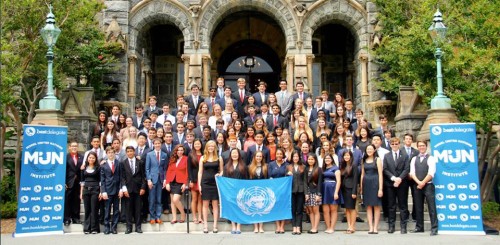
BestDelegate.com is one of several online MUN resources available. Best Delegate also runs the offline Model UN Institute.
The founding of BestDelegate.com in 2007* is significant** because it marked the beginning of the rise of dynamic online MUN resources that were created by Model UN participants for global MUN community use and not tethered to any particular conference or program. Prior to that, the UN Cyberschoolbus website and the UNA-USA website existed but their content was static rather than dynamic, and the few other resources online were mostly meant for participants of specific conferences and thus not widely known or applicable.
BestDelegate.com changed that by constantly publishing articles and resources that made it easier for hundreds of thousands of delegates to start doing MUN or improve in their MUN skills. It also published conference liveblogs and a conference database that made it easier for tens of thousands of participants to learn about and find MUN conferences to attend. Its significant influence on the growth of MUN worldwide could be summarized by its website traffic growth from 75,000 unique visitors in 2011 up to 650,000 unique visitors from 190+ countries in 2015. Furthermore, Best Delegate has made a significant impact on the quality and standardization of MUN training as thousands of students and teachers have attended their Model UN Institute and workshops held in 20 countries.
Other online MUN resources have developed in the past five years to address different needs, and many of these innovations have come from outside the United States. Prominent examples have included:
- The Model UN App, first released in 2010, was the first of several smartphone apps that made MUN resources mobile-friendly.
- Online Model United Nations (O-MUN) — founded in Jordan in 2011 but now a global THIMUN-affiliated program — brought MUN to many areas where in-person MUN conferences were inaccessible, such as the Middle East and Africa. Now, any student with Internet access could participate in an online MUN debate at all academic levels.
- MyMUN, founded in Germany in 2012, has enabled the growth of many newer MUN conferences by creating an online MUN-specific registration system.
- MUN Planet, founded in Serbia in 2013, has connected MUN participants together by creating an online MUN-specific social and knowledge network.
More online MUN resources are likely to develop — and some may even become obsolete — as technology rapidly changes and continues to shape lives in the 21st century. With less than five years of history for the majority of online MUN resources, the subsequent impact of the different players of Event #9 is still being formed.
—
*Notes: BestDelegate.com has been online since 2007, but Best Delegate as a Model UN organization was founded in 2010.
**Disclosure: Author is co-founder of Best Delegate.
10. 2009: The UN launched the UN4MUN initiative, potentially leading to a global growth or change of how MUNs are simulated
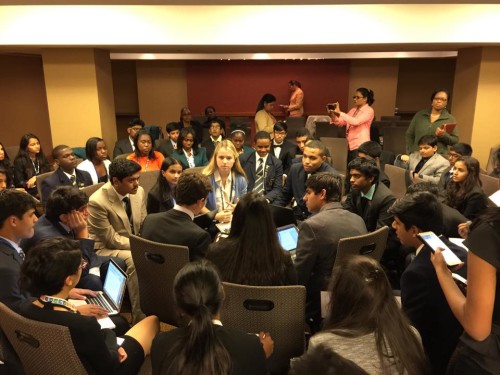
Delegates at WIMUN negotiate toward consensus on a single resolution, which in UN4MUN means there are no objections and a vote is not even needed.
The United Nations itself had not been actively involved for much of the history of its namesake activity, Model United Nations. Its indirect role consisted mostly of renting UN General Assembly Hall space to conferences such as NMUN, NHSMUN, and GCIMUN. Meanwhile, ECOSOC autonomously granted NGO observer status to several MUNs such as THIMUN and McGill’s conferences. This all changed in 2009, when the United Nations hosted its own conference called Global MUN because it realized how pretty much every Model UN conference in the world was using its name but simulating it inaccurately in procedure (e.g. the UN is not a parliament, so it does not use parliamentary procedure) and in practice (about 80% of resolutions are adopted by consensus, meaning voting is not the default goal for passing resolutions).
The UN Department of Public Information (UNDPI) rolled out UN4MUN procedure to help participants simulate UN procedures and practices as done in the real UN. UN4MUN has a focus on adoption of resolutions by consensus, meaning a vote is not even needed because there is no disagreement, which is important to ensure that sovereign Member States would implement resolutions in real life. This was in stark contrast to the existing MUN game of passing resolutions by simple majority, which did not encourage compromise with dissenting minority opinions once simple majority had been reached.
The UN ran three Global MUN conferences in three countries from 2009-2011 before switching to a UN4MUN Workshop format to broaden their reach, and workshops were run at least ten times in eight countries between 2012-2015. The World Federation of the United Nations Associations (WFUNA) — previously also not involved with Model UN — has become the de facto successor of Global MUN and the UN4MUN movement with its WFUNA International Model United Nations conference (WIMUN), whose second edition was held in 2015 at UN Headquarters in New York and in close partnership with UNDPI.
Although the history of UN involvement in Model UN is recent and the UN4MUN initiative has so far impacted only several thousand participants, UN4MUN has the potential to grow into a third major Model UN procedure to be adopted worldwide and change the way Model UNs are organized and simulated in the future. However, participants may be resistant to change or to the truth because their existing MUNs have a rich quality that has developed over time: history.
Bonus #11: The information technology revolution
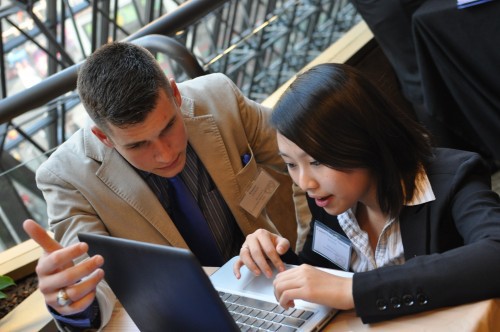
Technology has impacted Model UN research and simulations. It’d be hard to imagine doing MUN research without Google or other websites!
Although the information technology revolution is a larger global phenomenon that is not directly related to Model United Nations, it could be argued that it nonetheless had a significant impact on the quality of the activity. Many of the tech resources created roughly during the same time as the golden decade of Model UN growth between 1999-2009 cited in the introduction are now ubiquitously used in Model UN. In fact, it would be difficult to imagine modern-day Model UN without them! Examples include but are not limited to:
- 1998: Google was created. This search engine is used by the vast majority of Model UN participants in order to find MUN websites, research sources, and news.
- 2001: Wikipedia was created. This online encyclopedia is used by the vast majority of Model UN participants to start their research.
- 2004: Facebook was created. This social network and others are now used by the vast majority of Model UN participants to connect with each other.
- 2007: the iPhone was created. Smartphones in general are now used by Model UN participants for on-the-go research and communication at conferences, and multiple MUN-specific smartphone apps now exist.
Article References
Websites accessed between December 16-19, 2015 for research and citation. The links cited are meant to reference the organization’s claimed founding date on their website, but website content is always changing and the linked pages may not necessarily include this information if accessed after December 19, 2015.

